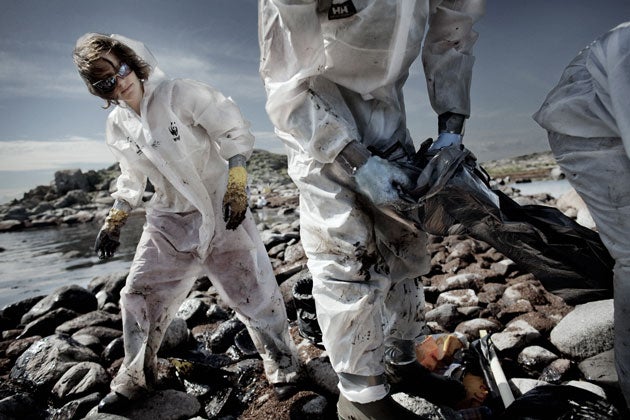Norway cleans up after oil spill
Wildlife reserves devastated as 200 tons of diesel from stricken tanker washes up on beaches

Your support helps us to tell the story
From reproductive rights to climate change to Big Tech, The Independent is on the ground when the story is developing. Whether it's investigating the financials of Elon Musk's pro-Trump PAC or producing our latest documentary, 'The A Word', which shines a light on the American women fighting for reproductive rights, we know how important it is to parse out the facts from the messaging.
At such a critical moment in US history, we need reporters on the ground. Your donation allows us to keep sending journalists to speak to both sides of the story.
The Independent is trusted by Americans across the entire political spectrum. And unlike many other quality news outlets, we choose not to lock Americans out of our reporting and analysis with paywalls. We believe quality journalism should be available to everyone, paid for by those who can afford it.
Your support makes all the difference.An oil tanker sits in a slick of 200 tons of diesel, 100 miles south of Norway's capital city, Oslo. Pictures, taken in the aftermath of the spill from the vessel, demonstrate the scale of the catastrophe: the usually picturesque beaches of Sastein and Langesund, site of wildlife sanctuaries and tourist beaches, have seen birds slaughtered and a massive clean-up operation has been launched following one of the country's worst oil disasters.
The boat, a Panama-registered freighter called Full City, ran aground in bad weather following engine trouble on 31 July. The 23-strong Chinese crew was immediately scrambled off the ship but not before much of the 1,100 tons of oil on board slipped into the sea off the village of Langesund and spread 100 miles along the coast.
It has now emerged that safety questions had been asked about the 167m tanker – thought to be owned by the Chinese-based shipping giant Cosco – on more than 30 occasions in 11 years by European harbour authorities. Last week the captain of the ship was charged for not warning the authorities it was in trouble during the storm. He was released on bail.
In the days following the disaster, one of Norway's worst, thousands of birds said to be part of the Lille Sastein bird sanctuary and which were covered in oil, were considered beyond saving and had to be shot. Hundreds more are being cleaned up by volunteers along the coastline.
Around 200 tons have been collected from the sea so far, while Norway's government comes up with a plan to deal with the ship which may yet have to be broken up where it stands.
Norwegian authorities, who have been criticised by conservationists for their apparent slow response, said efforts were focusing on protecting fjords, bays and rivers and blamed bad winds immediately after the spillage for spreading the oil to shores.
Join our commenting forum
Join thought-provoking conversations, follow other Independent readers and see their replies
Comments